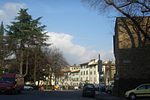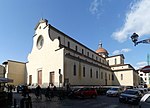Santa Elisabetta delle Convertite
14th-century Roman Catholic church buildings in ItalyChurches in FlorenceMagdalene asylums

Santa Elisabetta delle Convertite is a formerly Roman Catholic church on Via de' Serragli in the Oltrarno neighborhood of Florence region of Tuscany, Italy. Since 2015, the church has functioned as a Georgian Orthodox church. The former adjacent convent has multiple uses, including in 2016 as the Istituti Pio X Artigianelli.
Excerpt from the Wikipedia article Santa Elisabetta delle Convertite (License: CC BY-SA 3.0, Authors, Images).Santa Elisabetta delle Convertite
Via del Campuccio, Florence Quartiere 1
Geographical coordinates (GPS) Address External links Nearby Places Show on map
Geographical coordinates (GPS)
| Latitude | Longitude |
|---|---|
| N 43.765447222222 ° | E 11.244308333333 ° |
Address
Chiesa di Santa Elisabetta delle Convertite
Via del Campuccio
50125 Florence, Quartiere 1
Tuscany, Italy
Open on Google Maps











